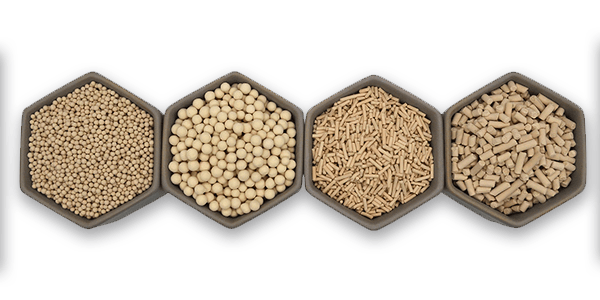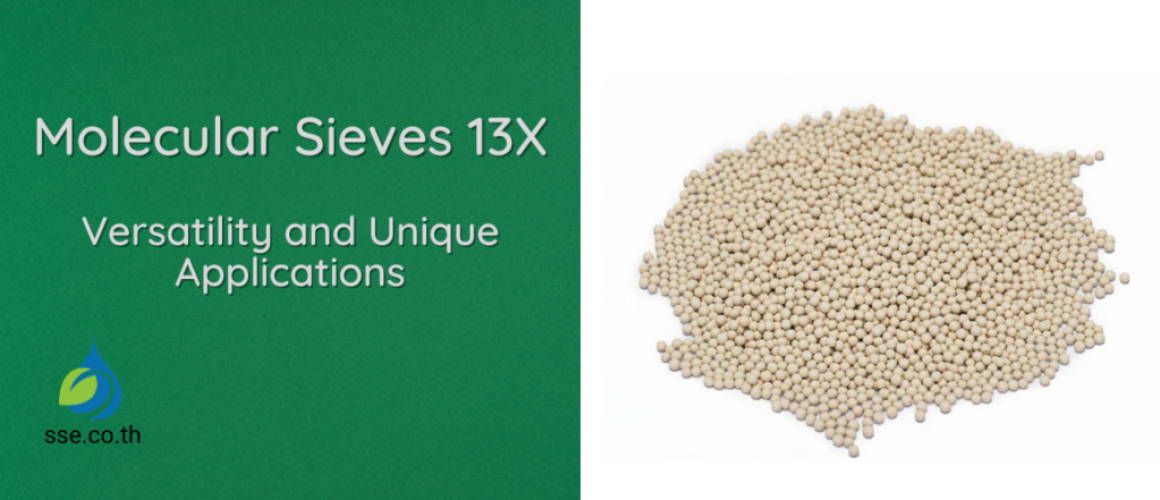The Versatility of 13X Molecular Sieves and Their Unique Applications


| Feature | Description |
|---|---|
| Pore Size | 10 angstroms, ideal for adsorbing larger molecules. |
| Composition | Sodium aluminosilicate, providing excellent adsorption properties. |
| Key Applications | Gas purification, oxygen production, solvent drying, petrochemical separation, wastewater treatment. |
| Advantages | High adsorption capacity, reusable, suitable for diverse industries. |
| Product Links | 13X 3-5 mm, 13X 1.6-2.5 mm |
Table of Contents
13x Molecular Sieves
Explore our available products for Molecular Sieve 13X:
Molecular Sieve 13X is one of the most versatile and widely used types of molecular sieves in various industries. Known for its large pore size of approximately 10 angstroms, Molecular Sieve 13X can adsorb molecules that are too large for other types of molecular sieves, such as 3A, 4A, and 5A. This versatility makes it suitable for a wide range of applications, from gas separation to drying and purifying liquids.


Properties of 13X Molecular Sieves
Properties of 13X Molecular Sieves
| Property | Description |
| Pore Size | 10 angstroms, allowing adsorption of larger molecules. |
| Composition | Sodium aluminosilicate, providing excellent adsorption properties. |
| Form | Available in spherical beads or pellets, in various sizes to meet industrial requirements. |
| Regeneration | Can be regenerated for reuse by heating, making it cost-effective and environmentally friendly. |
Regeneration Capability: Can be regenerated for reuse by heating to remove adsorbed substances, making it cost-effective and environmentally friendly.
Pore Size: 10 angstroms, allowing adsorption of larger molecules.
Composition: Sodium aluminosilicate, which provides excellent adsorption properties.
Form: Available in spherical beads or pellets, in various sizes to meet industrial requirements.
Key Applications of 13X Molecular Sieves
Key Applications of 13X Molecular Sieves
| Application | Description |
| Gas Purification | Used for removing contaminants like CO2, H2S, and moisture from gas streams, ensuring gas purity. |
| Oxygen Production | Key component in PSA units to separate oxygen from other gases, essential for medical and industrial uses. |
| Solvent Drying | Removes moisture and impurities from solvents, ensuring purity for chemical and pharmaceutical industries. |
| Petrochemical Industry | Used for separating hydrocarbons and purifying gas streams, improving product quality in refining processes. |
| Wastewater Treatment | Applied in removing contaminants from wastewater, useful in industries needing high purification levels. |
Gas Purification
Molecular Sieve 13X is widely used in gas purification, including the removal of contaminants such as CO2, H2S, and moisture from gas streams. This makes it indispensable for industries like natural gas processing, where the purity of gas is critical.
In the gas separation industry, 13X Molecular Sieves are used to remove carbon dioxide and water to prevent these components from freezing in cryogenic units. The larger pore size of 13X allows it to adsorb these molecules effectively, ensuring the proper functioning of air separation units.
Oxygen Production
Another major application of Molecular Sieve 13X is in the production of oxygen. It is a key component in Pressure Swing Adsorption (PSA) units, where it helps to separate oxygen from other gases, such as nitrogen. This makes it an essential part of oxygen concentrators, which are used in both medical and industrial settings.
Solvent Drying and Purification
Molecular Sieve 13X is also used for the drying and purification of solvents. Due to its high adsorption capacity, it can effectively remove moisture and impurities from organic solvents, ensuring that these solvents meet the necessary purity standards for chemical and pharmaceutical applications.
Petrochemical Industry
In the petrochemical industry, Molecular Sieve 13X is used for the separation of hydrocarbons and the purification of gas streams. Its ability to adsorb larger hydrocarbon molecules makes it ideal for refining and processing operations, improving the quality of the end products.
Wastewater Treatment
Molecular Sieve 13X can also be applied in advanced wastewater treatment processes. Its large pore size and adsorption properties enable it to capture and remove contaminants from wastewater, thus improving the quality of the treated water. This application is particularly useful in industries that require high levels of wastewater purification before discharge or reuse.
Advantages of Using 13X Molecular Sieves
Advantages of Using 13X Molecular Sieves
| Advantage | Description |
| High Adsorption Capacity | Large pore size allows adsorption of various molecules, suitable for many applications. |
| Efficiency | Effective in removing moisture, CO2, and other contaminants from gases and liquids. |
| Reusable | Can be regenerated for reuse, reducing waste and lowering operational costs. |
| Versatility | Suitable for a wide range of industries including healthcare, petrochemicals, and environmental sectors. |
- High Adsorption Capacity: The large pore size allows for the adsorption of a wide range of molecules, making it versatile for different applications.
- Efficiency: Effective in adsorbing moisture, CO2, and other contaminants from gases and liquids.
- Reusable: Can be regenerated and reused multiple times, which reduces waste and operational costs.
- Industrial Versatility: Suitable for a wide array of industries, including healthcare, petrochemicals, and environmental management.
Choosing the Right 13X Molecular Sieve for Your Needs
Choosing the Right 13X Molecular Sieve for Your Needs
| Factor | Considerations |
| Pore Size | Ensure the pore size matches the type of molecules you need to adsorb. |
| Adsorption Capacity | Higher capacity means more efficient removal of contaminants, suitable for your application. |
| Regeneration Capabilities | Check if the molecular sieve can be easily regenerated to suit your cost-efficiency needs. |
Choosing the right type of 13X Molecular Sieve depends on your specific requirements. Factors such as pore size, adsorption capacity, and regeneration capabilities should be considered. Whether you need to remove CO2 from gas streams or dry organic solvents, Molecular Sieve 13X offers a solution that combines efficiency, reliability, and cost-effectiveness.
For more detailed information on the various grades of Molecular Sieve 13X and their specific uses, feel free to contact us or visit our product pages: Molecular Sieve 13X 3-5 mm and Molecular Sieve 13X 1.6-2.5 mm.
Our Products
ลด CO2 และความชื้นด้วย 13x โมเลกุลลาร์ ซีฟ | ขายส่ง 125kg/กล่อง | คุณภาพดี | ตรวจสอบและกรองอากาศ
Frequently Asked Questions
What is 13X molecular sieve?
13X molecular sieve is a type of crystalline aluminosilicate with a unique pore structure. It is the sodium form of type X crystals and has a larger pore opening than type A crystals. This allows it to adsorb molecules with a kinetic diameter of less than 9 Angstrom (0.9 nm) and exclude larger ones, making it suitable for various applications, such as gas separation, purification, and dehydration.
What is the size of the 13X molecular sieve?
The pore size of 13X molecular sieve is approximately 9 Angstrom (0.9 nm), which allows it to adsorb molecules with a kinetic diameter of less than 0.9 nm and exclude larger ones.
What is the difference between 4A and 13X molecular sieves?
The primary difference between 4A and 13X molecular sieves lies in their pore size and adsorption properties. 4A molecular sieves have a smaller pore size of about 4 Angstrom (0.4 nm), while 13X molecular sieves have a larger pore size of 9 Angstrom (0.9 nm). This difference in pore size affects their adsorption properties, making them suitable for different applications.
What is the difference between zeolite 13X and 5A?
The main difference between zeolite 13X and 5A is their pore size and adsorption properties. Zeolite 13X has a pore size of approximately 9 Angstrom (0.9 nm), whereas zeolite 5A has a pore size of around 5 Angstrom (0.5 nm). This difference in pore size affects their adsorption properties, making them suitable for various applications.
What is the composition of 13X zeolite?
13X zeolite is an aluminosilicate material with a sodium ion as its charge-balancing cation. The chemical formula for 13X zeolite is typically represented as Na_86[(AlO_2)_86(SiO_2)_106]·nH_2O, where n represents the number of water molecules in the zeolite framework.
What is the adsorption capacity of zeolite 13X?
The adsorption capacity of zeolite 13X depends on the specific application and operating conditions. For instance, under typical conditions, the static H2O adsorption capacity of 13X molecular sieve can be ≥26.50% wt, and the static CO2 adsorption capacity can be ≥18.00% wt. The actual adsorption capacity may vary based on factors such as temperature, pressure, and the presence of other molecules.
What is the density of zeolite 13X?
The bulk density of zeolite 13X molecular sieve varies depending on the form (beads or pellets) and specific product, but it generally ranges between 0.60 and 0.65 g/ml.
What is the structure of zeolite 13X?
Zeolite 13X has a crystalline structure composed of a three-dimensional framework of SiO4 and AlO4 tetrahedra, interconnected by shared oxygen atoms. This framework creates a system of uniform pores and channels that enable selective adsorption of molecules based on their size and polarity.
Is zeolite 13X hydrophilic?
Yes, zeolite 13X is hydrophilic, which means it has an affinity for water. This property makes it highly effective for adsorbing water from various gas and liquid streams, as well as for applications that involve the removal of moisture.
What is zeolite 13X adsorbent molecular sieve?
Zeolite 13X adsorbent molecular sieve is a type of aluminosilicate material that has a highly porous structure with a uniform pore size of approximately 9 Angstrom (0.9 nm). This property makes it highly effective for selectively adsorbing specific molecules based on their size and polarity, which is useful for a wide range of applications, such as gas separation, purification, and dehydration.
What is the diameter of 13X zeolite?
The diameter of 13X zeolite molecular sieve beads typically ranges from 1.6 to 2.5 mm or 3.0 to 5.0 mm, depending on the specific product. The diameter of the pore openings within the zeolite structure is approximately 9 Angstrom (0.9 nm).
What is molecular sieve size?
Molecular sieve size refers to the diameter of the pore openings within the crystalline structure of the molecular sieve. The pore size determines the types of molecules that can be adsorbed by the sieve, making it a critical parameter for various applications. Molecular sieves are typically available in different pore sizes, such as 3A, 4A, 5A, and 13X, with each size having its own unique adsorption properties and applications.
Conclusion
In conclusion, 13X molecular sieves are a versatile and valuable tool for various industries, thanks to their unique adsorption properties and wide range of applications. Whether it’s air purification, gas separation, or dehydration processes, these molecular sieves can help enhance efficiency and improve the quality of end products.
Interested in learning more about the Versatility of Molecular Sieve 13x? Check out Your Comprehensive Guide to Molecular Sieves for an in-depth overview of how these versatile materials can enhance your operations. Feel free to reach out for more detailed information or consultation. Visit our Molecular Sieve category to explore all the available options, and discover how Molecular Sieve 13X can transform your operations.
Also, check out our previous posts about Molecular Sieve: The Role of Molecular Sieve 13X Catalyst Support in Advanced Wastewater Treatment Solutions , Troubleshooting Common Issues with Molecular Sieves, and Comparing Activated Alumina with Other Desiccants: Silica Gel, Molecular Sieve, and Activated Carbon
ความสำคัญของโมเลกุลลาร์ ซีฟ ในอุตสาหกรรมต่างๆ
https://pubs.acs.org/doi/pdf/10.1021/i160068a003
ขอบคุณที่ใช้เวลาอ่านบทความของเราเกี่ยวกับการป้องกันความชื้น ทางเราหวังว่าท่านจะได้รับข้อมูลที่มีคุณค่าและเป็นประโยชน์ ทางเรายินดีให้บริการการปรึกษาฟรีเพื่อพูดคุยเกี่ยวกับความต้องการของท่านและให้คำแนะนำเกี่ยวกับวิธีการป้องกันความชื้นที่กำหนดเฉพาะสำหรับคุณ โปรดติดต่อเราที่ 0858124188 เพื่อนัดหมายการปรึกษาหรือเยี่ยมชมร้านค้าของเราเพื่อค้นหาผลิตภัณฑ์ที่ช่วยป้องกันสินค้าของคุณจากความเสียหายจากความชื้น ทางเราหวังว่าจะได้รับข่าวสารจากท่านเร็วๆนี้
